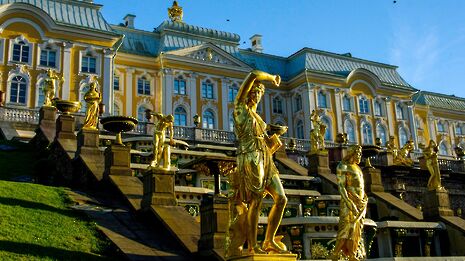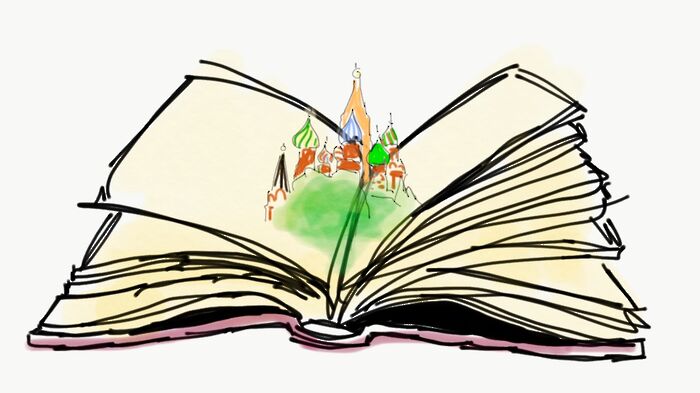Petersburg: a stay-at-home tourist’s guide to the possible
The following is intended to guide you across the strange and paradoxical landscape of St Petersburg, entering the city at the moment of its foundation and wandering down streets and across bridges into the present

In 1703, Tsar Peter I (“the Great”) decided to impose his authority on the elements. Defying the cautionary tale of Canute, he turned back the waves, raising the city that was to bear his name from the inhospitable marshlands of the Gulf of Finland. As fantastical as this decision may seem, it nevertheless had clear strategic purposes. Peter viewed his creation as a “window on the West” – a masterpiece of statesmanship which would move his country closer to the great powers of Europe, in both a geographical and a cultural sense. The foundation of Petersburg thus appeared to many Russians as a hubristic breach of the fundamental laws of nature and culture. In the popular imagination, the city was forever to remain connected to notions of unreality, artificiality and impermanence: seized from the elements, the new imperial capital could just as easily return to them.
“Coming across Peter the Great’s statue (the bronze horseman), he curses the man who chose to build a city so unnatural and so vulnerable”
Such perceptions fed a strong literary tradition in which Petersburg appears as a landscape of dreams. Alexander Pushkin’s The Bronze Horseman is perhaps the definitive portrayal of the city on these terms. Set during the flood of 1824, the narrative follows the sorrows of Evgenii, who loses his lover to the waves. Coming across Peter the Great’s statue (the bronze horseman), he curses the man who chose to build a city so unnatural and so vulnerable. Evgenii’s defiance is not allowed to go unpunished: stepping down from his pedestal, Peter once again defies the conventional bounds of reality and proceeds to chase this unfortunate to his death through the streets of the city. Similar motifs were to be taken up almost a century later in Andrei Bely’s wonderful and unsettling Petersburg, in which another young rebel (this time a young revolutionary) is pursued by the statue. Here, however, the collapse of a single, stable reality is even more emphatic. Bely’s novel is comprised of an endless series of fragmentary (and often entirely unconnected) images, which move the reader through his text at a relentless, unforgiving pace. In this sense, the restless drama of the horseman’s climatic chase is anticipated from the novel’s first page.
“The very fabric of the city seems ranged against revolution, illuminating the bravery and heroism of those who nevertheless engage in the struggle”
Yet this hallucinatory world co-exists in Russian literature with another Petersburg of assertive, concrete reality. This was the city of the early 20th century, in which hulking industrial works churned out china and matches, arms and steel, alongside a furious, organised and militant working-class politics determined to dismantle the status quo and create a new world. This Petersburg (then Petrograd) is represented in films such as Sergei Eisenstein’s October, as well as the powerful work of journalism (John Reed’s Ten Days that Shook the World) on which it is based. In such works – as in Pushkin and Bely – the city is a protagonist in its own right. For Reed, its very streets and buildings seem imbued with the revolutionary enthusiasm of the workers, supporting and accommodating the movement of the masses. Eisenstein elaborates on this theme in his depiction of the workers’ extended battle to seize the city from the existing government. In a famous sequence near the beginning of the film, the city’s bridges are raised in order to isolate the insurrection, containing it to the suburbs. The director presents these events in graphic and distressing detail, as desperate revolutionaries are thrown from the rising bridges. The very fabric of the city seems ranged against revolution, illuminating the bravery and heroism of those who nevertheless engage in the struggle. In a potent symbol of victory, the workers are later shown taking these same bridges. They perform a feat long depicted as impossible in Russian literature, and transform the landscape of autocracy into their own.
Thus, Petersburg can overall be considered a landscape of contradictions – a liminal space in which disparate and even antithetical ideas (reality and fantasy, human power and natural abandon) share a tense co-existence. One may further argue that it is precisely these paradoxes which generate a sense of the city as a world of the possible, and a space in which almost anything may be expected to occur.
For the busy student, approaching the texts outlined above may not be an immediate possibility. However, the curious but time-strapped reader need not despair. Several popular staples of Soviet cinema, including the light-hearted comedies Autumn Marathon and The Irony of Fate, may in fact introduce you to similar themes. In Autumn Marathon (which narrates the story of a University professor determined hide a love-affair from his wife) the city’s bridges reprise their roles as central characters. Here, however, their untimely raising serves as an excuse for the professor’s late return home to his justly suspicious wife. In the Irony of Fate, a simple Petersburg (then Leningrad) apartment block also appears as an active force driving the plot. In both cases, the city is the site of the unlikely and even (seemingly) impossible, as characters are thrown together and rushed towards their futures by an inexplicable but inevitable logic tied up with its buildings and streets. Nevertheless, despite the city’s centrality to its plot, The Irony of Fate does not conclude in Leningrad/Petersburg, rather carrying the viewer forward to Moscow. It is to this city – Petersburg’s traditional rival and foil – that we will travel to on the next stage of our journey.
 Comment / Plastic pubs: the problem with Cambridge alehouses 5 January 2026
Comment / Plastic pubs: the problem with Cambridge alehouses 5 January 2026 News / New movement ‘Cambridge is Chopped’ launched to fight against hate crime7 January 2026
News / New movement ‘Cambridge is Chopped’ launched to fight against hate crime7 January 2026 News / Uni-linked firms rank among Cambridgeshire’s largest7 January 2026
News / Uni-linked firms rank among Cambridgeshire’s largest7 January 2026 News / Cambridge businesses concerned infrastructure delays will hurt growth5 January 2026
News / Cambridge businesses concerned infrastructure delays will hurt growth5 January 2026 Features / Who gets to speak at the Cambridge Union?6 January 2026
Features / Who gets to speak at the Cambridge Union?6 January 2026










